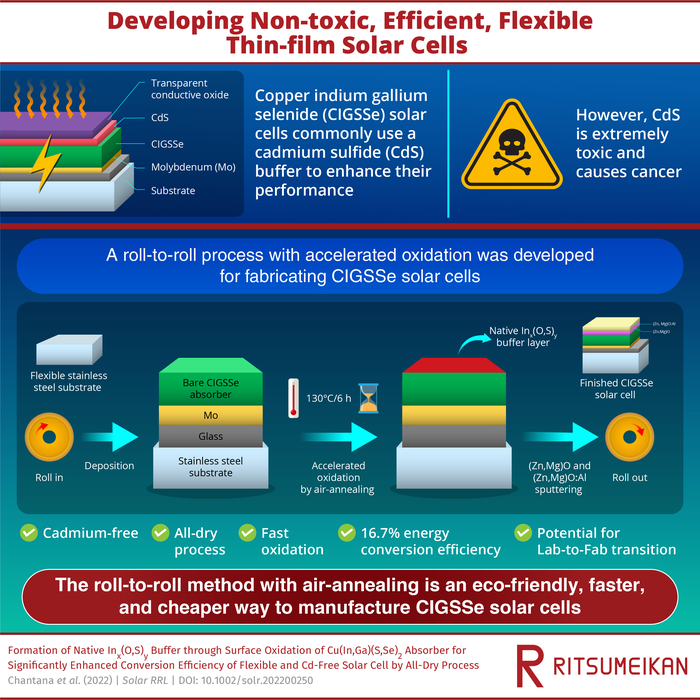For instance, copper indium gallium selenide (CIGSe) is a thin-film solar cell that offers several advantages over traditional silicon solar cells. Thin-film solar cells are about 100 times thinner, cheaper to make, and are easier to install on rooftops and vehicles. Moreover, compared to other photovoltaic materials used in thin-film solar cells like amorphous silicon, cadmium-telluride, and organic materials, CIGSe absorbs light more strongly and can be prepared into thinner films. However, they contain a buffer layer of cadmium sulfide, which is highly toxic and carcinogenic. This makes finding alternative, non-toxic materials essential for large-scale production and installation of CIGSe panels.
For Professors Jakapan Chantana and Takashi Minemoto at Ritsumeikan University, Japan, removing cadmium from solar cells was as important as developing an eco-friendly manufacturing process that is both efficient and affordable. Addressing these issues in a new study, a research team led by them developed a strategy in which the traditional cadmium sulfide buffer layer was replaced with a native buffer layer formed by oxidizing the surface of the Cu(In,Ga)(S,Se)2 CIGSSe layer with an air-annealing process. The study was published on March 26, 2022, in the journal Solar RRL.
While attempts to oxidize the CIGSSe layer have been made before, the surface usually takes months to oxidize. With the new method, however, the team reduced the oxidation time to a few hours, allowing for a faster manufacturing by a “roll-to-roll” process. In this process, a CIGSSe layer is initially deposited on a flexible stainless-steel substrate. The deposition is then followed by an air-annealing process where the surface of the CIGSSe layer is oxidized to form native buffer layers of Inx(O,S)y. By experimenting with different oxidation conditions, the researchers fabricated a CIGSSe solar cell with a maximum energy conversion efficiency of 16.7% after 6 hours of oxidation at 130°C.
“We have disclosed for the first time that the CIGSSe surface oxidized through an optimized air-annealing process leads to a strong enhancement in energy conversion efficiency,” says Prof. Minemoto.
Although the reported efficiency is lower than that of conventional solar cells (which typically exceed 20%), the developed method manages to do away with cadmium, making the solar cells eco-friendly. “In the conventional process, cadmium is deposited on the CIGSSe layer via a chemical bath deposition process. By eliminating this step, we have created a completely dry manufacturing process that generates less waste,” explains Prof. Chantana. Moreover, the process is also cost-effective.
In order to make solar energy a viable source of clean energy, solar panels must become more efficient, economical, and eco-friendly. “The method developed in our study can be scaled to large-scale manufacturing applications, which is what we need to make solar cells a clean energy resource not only in Japan but all over the world,” concludes Prof. Minemoto.
We certainly hope the vision shared by the researchers become a reality soon!
About Ritsumeikan University, Japan
Ritsumeikan University is one of the most prestigious private universities in Japan. Its main campus is in Kyoto, where inspiring settings await researchers. With an unwavering objective to generate social symbiotic values and emergent talents, it aims to emerge as a next-generation research university. It will enhance researcher potential by providing support best suited to the needs of young and leading researchers, according to their career stage. Ritsumeikan University also endeavors to build a global research network as a “knowledge node” and disseminate achievements internationally, thereby contributing to the resolution of social/humanistic issues through interdisciplinary research and social implementation.
Website: http://en.ritsumei.ac.jp/
About Professors Jakapan Chantana and Takashi Minemoto from Ritsumeikan University, Japan
Jakapan Chantana is a Professor at the Research Organization for Science and Technology at Ritsumeikan University. His research is focused on using eco-friendly techniques to develop thin-film solar cells and he has been involved with the development of a solar cell developed with an all-dry process having a world record energy conversion efficiency of 22%. He received his Ph.D. from Osaka University in 2012 and has been awarded the Young Researcher Paper award for his work on Photovoltaics. For more information, visit: https://research-db.ritsumei.ac.jp/rithp/k03/resid/S001002
Takashi Minemoto is a Professor at the Faculty of Science and Engineering Department of Electrical and Electronic Engineering at Ritsumeikan University. His research group deals with the development of next-generation, high-performance solar cells. He received his Ph.D. from Ritsumeikan University in 2003 and has published 135 papers till date. For more information, visit: https://research-db.ritsumei.ac.jp/rithp/k03/resid/S000034


